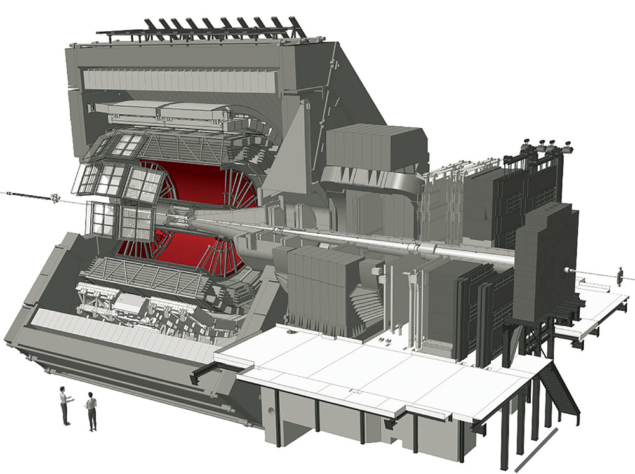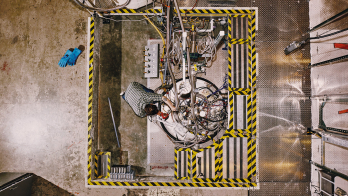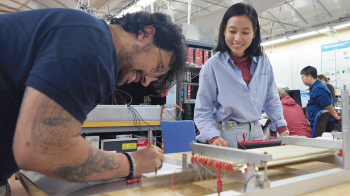The ALICE experiment is being tuned up to make even more precise measurements of the quark–gluon plasma and other extreme nuclear systems.

ALICE (A Large Ion Collider Experiment) will soon have enhanced physics capabilities thanks to a major upgrade of the detectors, data-taking and data-processing systems. These upgrades will improve the precision on measurements of the high-density, high-temperature phase of strongly interacting matter, the quark–gluon plasma (QGP), together with the exploration of new phenomena in quantum chromodynamics (QCD). Since the start of the LHC programme, ALICE has been participating in all data runs, with the main emphasis on heavy-ion collisions, such as lead–lead, proton–lead, and xenon–xenon collisions. The collaboration has been making major inroads into the understanding of the dynamics of the QGP – a state of matter that prevailed in the first instants of the universe and is recreated in droplets at the LHC.
To perform precision measurements of strongly interacting matter, ALICE must focus on rare probes – such as heavy-flavour particles, quarkonium states, real and virtual photons, and low-mass dileptons – as well as the study of jet quenching and exotic nuclear states. Observing rare phenomena requires very large data samples, which is why ALICE is looking forward to the increased luminosity provided by the LHC in the coming years. The interaction rate of lead ions during the LHC Run 3 is foreseen to reach around 50 kHz, corresponding to an instantaneous luminosity of 6 × 1027 cm–2 s–1. This will enable ALICE to accumulate 10 times more integrated luminosity (more than 10 nb–1) and a data sample 100 times larger than what has been obtained so far. In addition, the upgraded detector system will have better efficiency for the detection of short-lived particles containing heavy-flavour quarks thanks to the improved precision of the tracking detectors.
During long-shutdown two (LS2), several major upgrades to the ALICE detector will take place. These include: a new inner tracking system (ITS) with a new high-resolution, low-material-budget silicon tracker, which extends to the forward rapidities with the new muon forward tracker (MFT); an upgraded time projection chamber (TPC) with gas electron multiplier (GEM) detectors, along with a new readout chip for faster readout; a new fast interaction trigger (FIT) detector and forward diffraction detector. New readout electronics will be installed in multiple subdetectors (the muon spectrometer, time-of-flight detector, transition radiation detector, electromagnetic calorimeter, photon spectrometer and zero-degree calorimeter) and an integrated online–offline (O2) computing system will be installed to process and store the large data volumes.
Detector upgrades
A new all-pixel silicon inner tracker based on CMOS monolithic active pixel sensor (MAPS) technology will be installed covering the mid-rapidity (|η| < 1.5) region of the ITS as well as the forward rapidity (–3.6 < η < –2.45) of the MFT. In MAPS technology, both the sensor for charge collection and the readout circuit for digitisation are hosted in the same piece of silicon instead of being bump-bonded together. The chip developed by ALICE is called ALPIDE, and uses a 180 nm CMOS process provided by TowerJazz. With this chip, the silicon material budget per layer is reduced by a factor of seven compared to the present ITS. The ALPIDE chip is 15 × 30 mm2 in area and contains more than half a million pixels organised in 1024 columns and 512 rows. Its low power consumption (< 40 mW/cm2) and excellent spatial resolution (~5 μm) are perfect for the inner tracker of ALICE.

The ITS consists of seven cylindrical layers of ALPIDE chips, summing up to 12.5 billion pixels and a total area of 10 m2. The pixel chips are installed on staves with radial distances 22–400 mm away from the interaction point (IP). The beam pipe has also been redesigned with a smaller outer radius of 19 mm, allowing the first detection layer to be placed closer to the IP at a radius of 22.4 mm compared to 39 mm at present. The brand-new ITS detector will improve the impact parameter resolution by a factor of three in the transverse plane and by a factor of five along the beam axis. It will extend the tracking capabilities to much lower pT, allowing ALICE to perform measurements of heavy-flavour hadrons with unprecedented precision and down to zero pT.
In the forward-rapidity region, ALICE detects muons using the muon spectrometer. The new MFT detector is designed to add vertexing capabilities to the muon spectrometer and will enable a number of new measurements that are currently beyond reach. As an example, it will allow us to distinguish J/ψ mesons that are produced directly in the collision from those that come from decays of mesons that contain a beauty quark. The MFT consists of five disks, each composed of two MAPS detection planes, placed perpendicular to the beam axis between the IP and the hadron absorber of the muon spectrometer.
The TPC is the main device for tracking and charged-particle identification in ALICE. The readout rate of the TPC in its present form is limited by its readout chambers, which are based on multi-wire proportional chambers. In order to avoid drift-field distortions produced by ions from the amplification region, the present readout chambers feature a charge gating scheme to collect back-drifting ions that lead to a limitation of the readout rate to 3.5 kHz. To overcome this limitation, new readout chambers employing a novel configuration of stacks of four GEMs have been developed during an extensive R&D programme. This arrangement allows for continuous readout at 50 kHz with lead–lead collisions, at no cost to detector performance. The production of the 72 inner (one GEM stack each) and outer (three GEM stacks each) chambers is now practically completed and certified. The replacement of the chambers in the TPC will take place in summer 2019, once the TPC is extracted from the experimental cavern and transported to the surface.
The new forward interaction trigger, FIT, comprises two arrays of Cherenkov radiators with MCP–PMT sensors and a single, large-size scintillator ring. The arrays will be placed on both sides of the IP. It will be the primary trigger, luminosity and collision time-measurement detector in ALICE. The detector will be capable of triggering at an interaction rate of 50 kHz, with a time resolution better than 30 ps, with 99% efficiency.
The newly designed ALICE readout system presents a change in approach, as all lead–lead collisions that are produced in the accelerator, at a rate of 50 kHz, will be read out in a continuous stream. However, triggered readout will be used by some detectors and for commissioning and calibration runs and the central trigger processor is being upgraded to accommodate the higher interaction rate. The readout of the TPC and muon chambers will be performed by SAMPA, a newly developed, 32-channel front-end analogue-to-digital converter with integrated digital signal processor.
Performance boost
The significantly improved ALICE detector will allow the collaboration to collect 100 times more events during LHC Run 3 compared to Run 1 and Run 2, which requires the development and implementation of a completely new readout and computing system. The O2 system is designed to combine all the computing functionalities needed in the experiment: detector readout, event building, data recording, detector calibration, data reconstruction, physics simulation and analysis. The total data volume produced by the front-end cards of the detectors will increase significantly, reaching a sustained data throughput of up to 3 TB/s. To minimise the requirements of the computing system for data processing and storage, the ALICE computing model is designed for a maximal reduction in the data volume read out from the detectors as early as possible during the data processing. This is achieved by online processing of the data, including detector calibration and reconstruction of events in several steps synchronously with data taking. At its peak, the estimated data throughput to mass storage is 90 GB/s.

A new computing facility for the O2 system is being installed on the surface, near the experiment. It will have a data-storage system with a storage capacity large enough to accommodate a large fraction of data of a full year’s data taking, and will provide the interface to permanent data storage at the tier-0 Grid computing centre at CERN, as well as other data centres.
ALICE upgrade activities are proceeding at a frenetic pace. Soon after the machine stopped in December, experts entered the cavern to open the massive doors of the magnet and started dismounting the detector in order to prepare for the upgrade. Detailed planning and organisation of the work are mandatory to stay on schedule, as Arturo Tauro, the deputy technical coordinator of ALICE explains: “Apart from the new detectors, which require dedicated infrastructure and procedures, we have to install a huge number of services (for example, cables and optical fibres) and perform regular maintenance of the existing apparatus. We have an ambitious plan and a tight schedule ahead of us.”
When the ALICE detector emerges revitalised from the two busy and challenging years of work ahead, it will be ready to enter into a new era of high-precision measurements that will expand and deepen our understanding of the physics of hot and dense QCD matter and the quark–gluon plasma.
Further reading
ALICE Collaboration 2014 J. Phys. G 41 087002.
ALICE Collaboration 2015 CERN-LHCC-2015-001.
ALICE Collaboration 2014 CERN-LHCC-2013-019.
ALICE Collaboration 2014 CERN-LHCC-2013-020.
ALICE Collaboration 2015 CERN-LHCC-2015-006.








